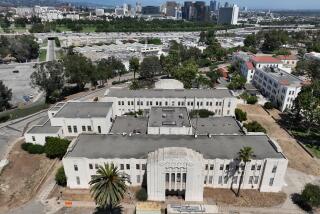L.A. revives a denser vision for Woodland Hills’ Warner Center
- Share via
When developers vowed in the early 1970s to create a “downtown” for the San Fernando Valley on movie mogul Harry Warner’s sprawling Woodland Hills horse ranch, many locals scoffed.
The Valley was, after all, where people had come for quiet suburban space, not major commerce.
Planners envisioned a futuristic high-rise commercial center towering above the flat landscape of single-family houses. By the 1980s, Warner Center had sprouted a small skyline and was home to two malls and a thriving aerospace industry.
Then the economy tanked and the building boom stopped. A new 25-story office tower sat empty for several years.
Once again, Los Angeles has plans for dense, urban-style developments in the quintessentially suburban West Valley.
The City Council has signed off on zoning that allows for up to 30 million square feet of commercial space in Warner Center, double the amount that currently exists. The plan also lifts building height limits governing most of the 1.5-square-mile district bounded by the 101 Freeway, Vanowen Street, DeSoto Avenue and Topanga Canyon Boulevard.
Officials are betting that the kind of dense, walkable communities thriving in downtown, Hollywood and other parts of Los Angeles can work 26 miles from the city center.
“Why is it important to build here? So people don’t have to be in traffic for a half-hour, 45 minutes to go someplace else,” Mayor Eric Garcetti said on a recent tour of the area. “That’s bad for them, but it’s bad for the rest of us too.”
It remains to be seen whether boosters can sell their vision.
“People didn’t come to the Valley, initially, to live in a concentrated place,” said Henrik Minassians, a professor of urban studies and planning at Cal State Northridge. “They were wanting to live in the suburbs.”
Said 28-year-old Jessica Gonzalez, who lives in nearby West Hills: “It’s the Valley. If you want to have downtown, you can go downtown.”
Even supporters of Warner Center concede that it needs a distinct identity to succeed.
“The Valley can’t try to be something it’s not. It has to keep its own personality,” said David Allison, chairman of the nonprofit Warner Center Assn. “The groundwork has been laid to create a city center; it’s feasible. Now, the question is the market and if there will be demand.”
One of the forces driving development is the Orange Line, Metro’s busway that runs from North Hollywood to Chatsworth, with a stop in Warner Center. The Orange Line has been a success, exceeding ridership projections and prompting talks of converting it to light rail.
Over the last several years, Warner Center has seen a boom in residential development, and more is on the way. The Warner Center 2035 plan, the city’s master plan, would boost the number of residential units from about 8,500 to more than 26,000, said Tom Glick, a city planner.
“It’s a suburban area that’s evolving,” said Dennis DiBiase, a member of the Woodland Hills-Warner Center Neighborhood Council who has lived there for more than two decades. “It’s becoming more urbanized and more dense. This is something unique for the area.”
Among the projects planned is a $3-billion high-rise “urban neighborhood” at the 47-acre former Rocketdyne engine manufacturing plant on Canoga Avenue, across the street from the busway.
The mixed-use project would have up to 3.95 million square feet of residential space and 1.1 million square feet of office space. Preliminary plans also call for an assisted-living facility, restaurants, a hotel and a 5-acre central park.
This spring, construction crews broke ground on a $350-million open-air mall that will occupy 30 acres between Victory Boulevard and Erwin Street. The Village at Westfield Topanga will house a Costco and an array of restaurants and outdoor courtyards.
Other plans include a 621-unit mixed-use apartment complex on the former Catalina Yachts building site on Victory Boulevard, as well as 379 apartment units on the site of the old Daily News headquarters at Oxnard Street and Canoga Avenue.
A 395-unit apartment project at De Soto Avenue and Erwin Street is expected to open this year.
The Warner Center 2035 plan is designed to unify all these projects.
It divides the area into eight districts with names such as Downtown, Uptown and Commerce, each with its own development guidelines. The plan calls for the long city blocks to be broken up with new pedestrian pathways, new streets and more crosswalks. Developers will pay fees to fund many of the changes.
In some ways, it’s a return to Warner’s Center original vision.
Identified by city planners in the 1970s, the area was slated to be one of several “urban hubs” where dense development would be allowed. The goal was to tame suburban sprawl and connect the various hubs with mass transit.
But the plan never really got off the ground, in part because of neighborhood opposition and also because the mass transit never materialized.
“Today, it’s a completely different environment, a different generation, a different way of thinking,” Minassians said. “More people want to experience urban living.”
Ethan Kern, 20, and Jessica Valice, 18, grew up near Warner Center. Standing in line at a food truck on Owensmouth Avenue, they said the area has a reputation for being boring.
“Having more night life would be good,” Kern said. “There are a lot of times there’s nothing to do around here.”
Valice agreed: “You can’t just be in the mall all day.”
Twitter: @haileybranson
More to Read
Sign up for Essential California
The most important California stories and recommendations in your inbox every morning.
You may occasionally receive promotional content from the Los Angeles Times.











